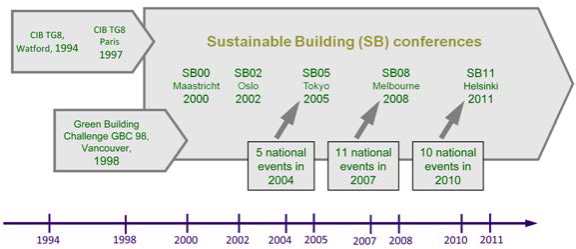Basic HTML Version


136
137
SB conference timeline
Assessment, rating, labeling & certification
History
BREEAM and LEED market penetration
Assessment: an evaluation
Rating: a score or result relative to a norm or global benchmark. Ratings can be based on self-
assessment or carried out by third parties.
Certification: validation of rating or assessment results by a knowledgeable third party that is
independent of both the developer / designer and the tool developer.
Labeling: proof of a rating or certification result, issued by the certifier.
Early 1990’s: the Building Research Establishment Environmental Assessment Method (BREE-
AM) was developed by BRE and a privatesector architect, John Doggart; Mid 1990’s: the Leader-
ship in Energy and Environmental Design (LEED) was developed by the U.S. Green Building Coun-
cil (USGBC);
Both of these initiatives began essentially as checklists of what to do and what not to do in the
design of commercial buildings;
These systems provided guidelines for good design and management suited to the region of ori-
gin;
As the field developed, more emphasis was placed on the assessment of performance, but some
of the guideline aspects remained, so we might call them hybrid systems;
Many other systems have been developed, e.g. CASBEE, Greenstar, etc., with most following the
similar pattern.
A 2008 BREEAM document shows that 116,000 buildings are certified while 714,000 buildings
have been registered, a higher level of penetration, but still small compared to total starts;
A USGBC document from 2009 indicated that the total of LEED Certified projects at the end of
Concept and objectives
The most relevant innovative
Elements of OPEN HOUSE are:
The overall objective of OPEN HOUSE is to develop and to implement a common European
transparent building assessment methodology, complementing the existing ones, for planning and
constructing sustainable buildings by means of an open approach and technical platform. OPEN
HOUSE baseline are existing standards (both CEN/TC 350 and ISO TC59/ SC17), the EPBD Direc-
tive and its national transpositions and methodologies for assessing building sustainability at inter-
national, European and national level.
It is designed and developed by a transparent and consensus process. Therefore, it is automati-
cally suitable for all European countries.
It is a non proprietary method, thus fostering the exploitation.
It is a comprehensive and user-friendly methodology, support by an interactive web tool (OPEN
HOUSE Plat-form) that will facilitate the communication and interaction between the building stake-
holders.
It is based on international/European standards.
It is based on objective, scientifically rigorous and stringent performance criteria.
Address the unresolved issues concerning building sustainability (e.g. performance requirements
such as accessibility, weighting, variables such a building type, target user and climate). elements
of OPEN HOUSE
Develop new indicators, especially those related with economic and social factors, like for ex-
ample safety and security, spaces for privacy or conviviality (e.g. co-housing, cafeteria in a office
building), externalities (e.g. use of local services or products, unemployment rate of the area), Eu-
ropean concept of cost and value (the cost for improving the labeling classification of the building,
value of the labeled building after a time period, value for policy makers and end users), radioactive
wastes, etc.
2008 was 2,476;
This is a cumulative total since 2000, so it represents a miniscule proportion of total construction
starts;
The small proportion of certified v. registered projects probably reflects the high educational value
of being registered v. the high cost of certification, which includes consulting fees for data prepara-
tion and also commissioning.
доклади
доклади

